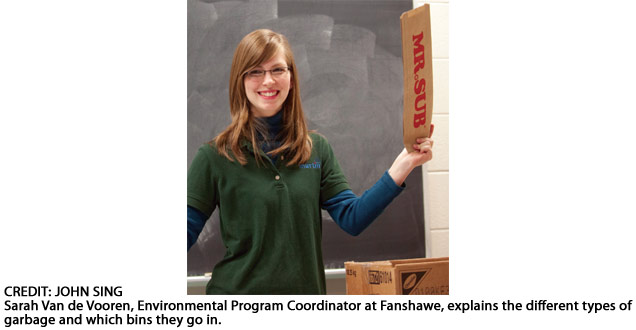Creating a diversion on campus no easy task

Fanshawe's Environmental Program Coordinator wants to create a diversion with students — a waste diversion, that is.
"The government regulations for an institution of our size has an expectation that we would achieve about a 60 per cent diversion rate," explained Sarah Van de Vooren, Environmental Program Coordinator at Fanshawe, when she chatted with first-year Culinary Management students in late January about the waste diversion program. A diversion rate is measured by dividing the amount of waste that is recycled by the total waste generated by an institution. The resulting number is the percentage rate of diversion. Fanshawe is currently at 47 per cent — a number Van de Vooren wants to rally students to increase.
Currently the college has recycling and compost programs in place, and Van de Vooren asked the students to come up with some new ideas about how Fanshawe can divert more garbage from landfills and into recycling.
Students had a variety of suggestions, ranging from increasing the number of garbage and recycling bins on campus to more visible labeling for existing bins. One student suggested creating a program on campus to recycle milk containers, which currently have to be put in the garbage. Another suggestion was that the school uses the compost collected from the compost bins throughout the campus in the greenhouses.
In addition to hearing from students, Van de Vooren offered some more eco-friendly suggestions of her own, including doing more to promote the eco-tainers available at the Oasis restaurant, which many of the Culinary Management students said they had not been aware of. "You take the card into Oasis, you give them the card, they serve your food in a reusable clamshell, you take it wherever you want, you eat the food, you don't even have to clean it — you just bring it back to Oasis, and they give you your card back, and you get to repeat the process over and over again," she explained. "It's a fantastic idea." The card has a onetime cost of $3, while the clamshell containers that are thrown out after use cost 25� apiece. She also suggested students bring a reusable coffee cup to school rather than use the ones from the coffee shops on campus. "Fanshawe generates over a million (Tim Hortons cups) every year," she added.
Another initiative Van de Vooren is undertaking is a survey of the general campus body about waste diversion. "I'm looking for students who would want to help design, implement, execute, analyze and report (the survey) � that will be seen by the college and will be used for investing in the infrastructure of the college. If you're interested in having a hands-on involvement in making change with our waste diversion program on campus, that's a great opportunity."
If you have any questions or you want to volunteer to help with the survey or any other upcoming initiatives, contact Van de Vooren at recycle@fanshawec.ca.
WHAT GOES WHERE?
COMPOST
Pizza Pizza cardboard slice holder
Soiled wax paper (the kind your sandwich comes wrapped in)
Clamshell container from B Cafeteria
Coyote Jacks fry cup
Paper products soiled with food waste
Olive Oyle's coffee cups and soup bowls
Paper Recycling
Mr. Sub bags
Tim Hortons Recycling Bins
Tim Hortons cups (NO LIDS)
Plastic Recycling
1 and 2 plastics (you can recycle 1 through 7 at home)
Water bottles
Pop bottles
Juice bottles
Garbage
Clamshell containers from Oasis
Dip cups
Cups, lids and straws
Plastic spoons, forks and knives
Tim Hortons lids













